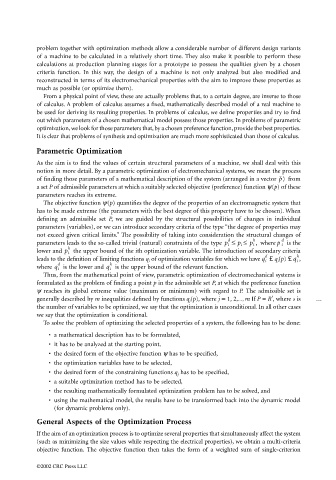Page 1006 - The Mechatronics Handbook
P. 1006
problem together with optimization methods allow a considerable number of different design variants
of a machine to be calculated in a relatively short time. They also make it possible to perform these
calculations at production planning stages for a prototype to possess the qualities given by a chosen
criteria function. In this way, the design of a machine is not only analyzed but also modified and
reconstructed in terms of its electromechanical properties with the aim to improve these properties as
much as possible (or optimize them).
From a physical point of view, these are actually problems that, to a certain degree, are inverse to those
of calculus. A problem of calculus assumes a fixed, mathematically described model of a real machine to
be used for deriving its resulting properties. In problems of calculus, we define properties and try to find
out which parameters of a chosen mathematical model possess those properties. In problems of parametric
optimization, we look for those parameters that, by a chosen preference function, provide the best properties.
It is clear that problems of synthesis and optimization are much more sophisticated than those of calculus.
Parametric Optimization
As the aim is to find the values of certain structural parameters of a machine, we shall deal with this
notion in more detail. By a parametric optimization of electromechanical systems, we mean the process
of finding those parameters of a mathematical description of the system (arranged in a vector p) from
a set P of admissible parameters at which a suitably selected objective (preference) function ψ(p) of these
parameters reaches its extreme.
The objective function ψ(p) quantifies the degree of the properties of an electromagnetic system that
has to be made extreme (the parameters with the best degree of this property have to be chosen). When
defining an admissible set P, we are guided by the structural possibilities of changes in individual
parameters (variables), or we can introduce secondary criteria of the type “the degree of properties may
not exceed given critical limits.” The possibility of taking into consideration the structural changes of
parameters leads to the so-called trivial (natural) constraints of the type p i ≤ p i ≤ p i , where p i d is the
h
d
h
lower and p i the upper bound of the ith optimization variable. The introduction of secondary criteria
d h
leads to the definition of limiting functions q i of optimization variables for which we have £ q i (p) £ q i q i ,
d h
where q i is the lower and q i is the upper bound of the relevant function.
Thus, from the mathematical point of view, parametric optimization of electromechanical systems is
formulated as the problem of finding a point p in the admissible set P, at which the preference function
ψ reaches its global extreme value (maximum or minimum) with regard to P. The admissible set is
s
generally described by m inequalities defined by functions q j (p), where j = 1, 2, ..., m. If P = R , where s is ...
the number of variables to be optimized, we say that the optimization is unconditional. In all other cases
we say that the optimization is conditional.
To solve the problem of optimizing the selected properties of a system, the following has to be done:
• a mathematical description has to be formulated,
• it has to be analyzed at the starting point,
• the desired form of the objective function ψ has to be specified,
• the optimization variables have to be selected,
• the desired form of the constraining functions q j has to be specified,
• a suitable optimization method has to be selected,
• the resulting mathematically formulated optimization problem has to be solved, and
• using the mathematical model, the results have to be transformed back into the dynamic model
(for dynamic problems only).
General Aspects of the Optimization Process
If the aim of an optimization process is to optimize several properties that simultaneously affect the system
(such as minimizing the size values while respecting the electrical properties), we obtain a multi-criteria
objective function. The objective function then takes the form of a weighted sum of single-criterion
©2002 CRC Press LLC

